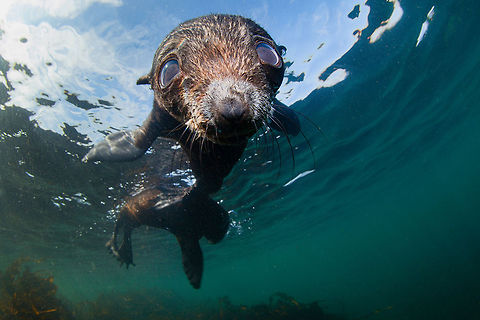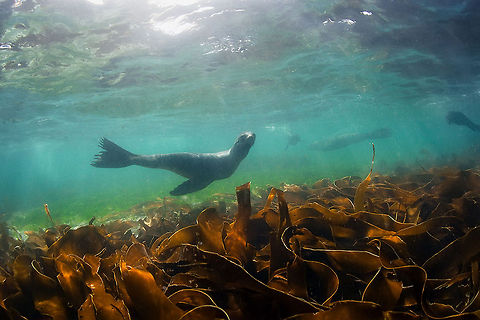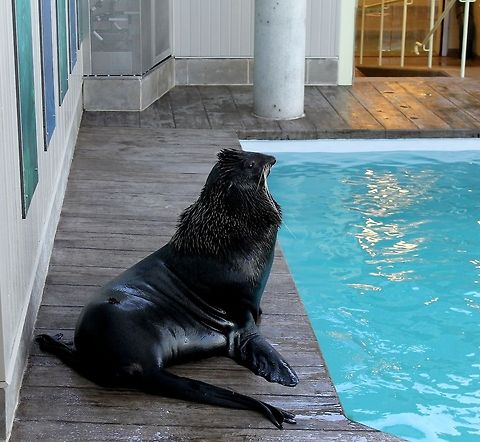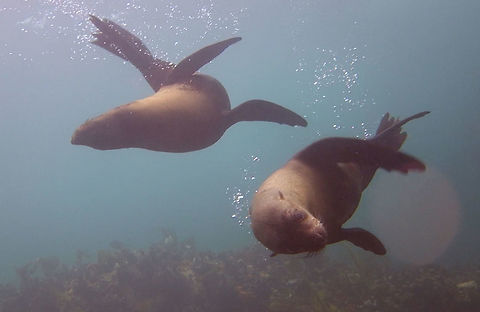
Appearance
Northern fur seals have extreme sexual dimorphism, with males being 30–40% longer and more than 4.5 times heavier than adult females. The head is foreshortened in both sexes because of the very short, down-curved muzzle, and small nose, which extends slightly beyond the mouth in females and moderately in males. The pelage is thick and luxuriant, with a dense underfur that is a creamy color. The underfur is obscured by the longer guard hairs, although it is partially visible when the animals are wet. Features of both fore and hindflippers are unique and diagnostic of the species. Fur is absent on the top of the foreflippers and there is an abrupt "clean line" across the wrist where the fur ends. The hindflippers are proportionately the longest in any otariid because of extremely long, cartilaginous extensions on all of the toes. There are small claws on digits 2–4, well back from the flap-like end of each digit. The ear pinnae are long and conspicuous, and naked of dark fur at the tips in older animals. The mystacial vibrissae can be very long, and regularly extend beyond the ears. Adults have all white vibrissae, juveniles and subadults have a mixture of white and black vibrissae, including some that have dark bases and white ends, and pups and yearlings have all black vibrissae. The eyes are proportionately large and conspicuous, especially on females, subadults, and juveniles.Adult males are stocky in build, and have enlarged necks. A mane of coarse, longer guard hairs extends from the lower neck to the shoulders. and covers the nape, neck, chest, and upper back. While the skulls of adult males are large and robust for their overall size, their heads appear short because of the combination of a short muzzle, and the backs of the head behind the ear pinnae being obscured by the enlarged necks. Adult males have abrupt foreheads formed by the elevation of the crown from development of the sagittal crests, and thicker fur of the mane on the top of their heads.
Canine teeth are much longer and have a greater diameter in adult males than those found on adult females, and this relationship holds to a lesser extent at all ages.
Adult females, subadults and juveniles, are moderate in build. Distinguishing the sexes is difficult until about age five. The body is modest in size and the neck, chest, and shoulders are sized in proportion with the torso. Adult females and subadults have more complex and variable coloration than adult males. They are dark-silver-gray to charcoal above. The flanks, chest, sides, and underside of the neck, often forming a chevron pattern in this area, are cream to tan with rusty tones. There are variable cream to rust-colored areas on the sides and top of the muzzle, chin, and as a "brush stroke" running backwards under the eye. In contrast, adult males are medium gray to black, or reddish to dark brown all over. Their manes can have variable amounts of silver-gray or yellowish tinting on the guard hairs. Pups are blackish at birth, with variable oval areas of buff on the sides, in the axillary area, and on the chin and sides of the muzzle. After three to four months, pups molt to the color of adult females and subadults.
Males can be as large as 2.1 m and 270 kg. Females can be up to 1.5 m and 50 kg or more. Newborns weigh 5.4–6 kg, and are 60–65 cm long.
The teeth are haplodont, i.e. sharp, conical and mostly single-rooted, as is common with carnivorous marine mammals adapted to tearing fish flesh. As with most caniforms, the upper canines are prominent. The dental formula of the adult is 3.1.4.2/2.1.4.1
...hieroglyph snipped...

Status
Recently, concern about the status of fur seal populations has increased, particularly in the Pribilof Islands, where pup production has decreased about 50% since the 1970s, with a continuing drop of about 6–7% per year. This has caused them to be listed as "vulnerable" under the U.S. Endangered Species Act, and has led to an intensified research program into their behavioral and foraging ecology. Possible causes are increased predation by orcas, competition with fisheries and climate change effects, but there is, to date, no scientific consensus. The IUCN lists the species as globally threatened under the category "vulnerable".
Behavior
Seals aggregate on traditional breeding grounds in May. Generally, older males return first and compete for prime breeding spots on the rookeries. They will remain on the rookery, fasting throughout the duration of the breeding season. The females come somewhat later, and give birth shortly thereafter. Like all other otariids, northern fur seals are polygynous, with some males breeding with up to 50 females in a single breeding season. Unlike Steller sea lions, with whom they share habitat and some breeding sites, northern fur seals are possessive of individual females in their harem, often aggressively competing with neighboring males for females. Deaths of females as a consequence of these conflicts have been recorded, though the males themselves are rarely seriously injured. Young males unable to acquire and maintain a territory of a harem typically aggregate in neighboring "haulouts" occasionally making incursions into the reproductive sections of the rookery in an attempt to displace an older male.After remaining with their pups for the first eight to ten days of their life, females begin foraging trips lasting up to a week. These trips last for about four months before weaning, which happens abruptly, typically in October. Most of the animals on a rookery enter the water and disperse towards the end of November, typically migrating southward. Breeding site fidelity is generally high for fur seals females, though young males might disperse to other existing rookeries, or occasionally found new haulouts.
Peak mating occurs somewhat later than peak birthing from late June to late July. As with many other otariids, the fertilized egg undergoes delayed implantation: after the blastocyst stage occurs, development halts and implantantion occurs four months after fertilization. In total, gestation lasts for approximately one year, such that the pups born in a given summer are the product of the previous year's breeding cycle.

Habitat
Fur seals are opportunistic feeders, primarily feeding on pelagic fish and squid depending on local availability. Identified fish prey include hake, herring, lantern fish, capelin, pollock and mackerel. Their feeding behavior is primarily solitary.Northern fur seals are preyed upon primarily by sharks and orcas. Occasionally, very young animals will be eaten by Steller sea lions. Occasional predation on live pups by arctic foxes has also been observed.
Due to very high densities of pups on reproductive rookeries and the early age at which mothers begin their foraging trips, mortality can be relatively high. Consequently, pup carcasses are important in enriching the diet of many scavengers, in particular gulls and arctic foxes.
Reproduction
Seals aggregate on traditional breeding grounds in May. Generally, older males return first and compete for prime breeding spots on the rookeries. They will remain on the rookery, fasting throughout the duration of the breeding season. The females come somewhat later, and give birth shortly thereafter. Like all other otariids, northern fur seals are polygynous, with some males breeding with up to 50 females in a single breeding season. Unlike Steller sea lions, with whom they share habitat and some breeding sites, northern fur seals are possessive of individual females in their harem, often aggressively competing with neighboring males for females. Deaths of females as a consequence of these conflicts have been recorded, though the males themselves are rarely seriously injured. Young males unable to acquire and maintain a territory of a harem typically aggregate in neighboring "haulouts" occasionally making incursions into the reproductive sections of the rookery in an attempt to displace an older male.After remaining with their pups for the first eight to ten days of their life, females begin foraging trips lasting up to a week. These trips last for about four months before weaning, which happens abruptly, typically in October. Most of the animals on a rookery enter the water and disperse towards the end of November, typically migrating southward. Breeding site fidelity is generally high for fur seals females, though young males might disperse to other existing rookeries, or occasionally found new haulouts.
Peak mating occurs somewhat later than peak birthing from late June to late July. As with many other otariids, the fertilized egg undergoes delayed implantation: after the blastocyst stage occurs, development halts and implantantion occurs four months after fertilization. In total, gestation lasts for approximately one year, such that the pups born in a given summer are the product of the previous year's breeding cycle.
References:
Some text fragments are auto parsed from Wikipedia.